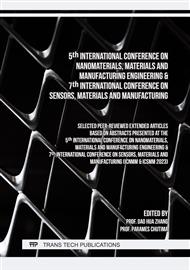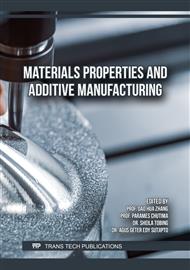[1]
Cardoso, Paulo Henrique Machado de Oliveira, Marcelo Ferreira Leão de Oliveira, Marcia Gomes da Silva Moreira Thiré RM. 3D Printed Parts of Polylactic Acid Reinforced with Carbon Black and Alumina Nanofillers for Tribological Applications. Macromolecular Symposia 2020; 394:1–13.
DOI: 10.1002/masy.202000155
Google Scholar
[2]
Velu R, Raspall F, Singamneni S. 3D printing technologies and composite materials for structural applications. Elsevier Ltd; 2018. https://doi.org/10.1016/B978-0-08- 102177-4.00008-2.
DOI: 10.1016/b978-0-08-102177-4.00008-2
Google Scholar
[3]
Cano S, Gonzalez-Gutierrez J, Sapkota J, Spoerk M, Arbeiter F, Schuschnigg S, et al. Additive manufacturing of zirconia parts by fused filament fabrication and solvent debinding: Selection of binder formulation. Additive Manufacturing 2019; 26:117–28. https://doi.org/.
DOI: 10.1016/j.addma.2019.01.001
Google Scholar
[4]
Wang, Xin, Jiang, Man, Zhou, Zuowan, Gou, Jihua, Hui D. 3D printing of polymer matrix composites: A review and prospective. Composites Part B: Engineering 2017; 110:442–58.
DOI: 10.1016/j.compositesb.2016.11.034
Google Scholar
[5]
Ziemian CW, Ziemian RD, Haile K v. Characterization of stiffness degradation caused by fatigue damage of additive manufactured parts. Materials and Design 2016; 109:209–18.
DOI: 10.1016/j.matdes.2016.07.080
Google Scholar
[6]
Liu Z, Wang Y, Wu B, Cui C, Guo Y, Yan C. A critical review of fused deposition modeling 3D printing technology in manufacturing polylactic acid parts. International Journal of Advanced Manufacturing Technology 2019; 102: 2877–89.
DOI: 10.1007/s00170-019-03332-x
Google Scholar
[7]
Ferreira RTL, Amatte IC, Dutra TA, Bürger D. Experimental characterization and micrography of 3D printed PLA and PLA reinforced with short carbon fibers. Composites Part B: Engineering 2017; 124:88–100.
DOI: 10.1016/j.compositesb.2017.05.013
Google Scholar
[8]
Singh R, Bedi P, Fraternali F, Ahuja IPS. Effect of single particle size, double particle size and triple particle size Al2O3 in Nylon-6 matrix on mechanical properties of feed stock filament for FDM. Composites Part B: Engineering 2016; 106:20–7. https://doi.org/.
DOI: 10.1016/j.compositesb.2016.08.039
Google Scholar
[9]
Peng F, Vogt BD, Cakmak M. Complex flow and temperature history during melt extrusion in material extrusion additive manufacturing. Additive Manufacturing 2018; 22: 197–206.
DOI: 10.1016/j.addma.2018.05.015
Google Scholar
[10]
Garg A, Bhattacharya A. An insight to the failure of FDM parts under tensile loading: finite element analysis and experimental study. International Journal of Mechanical Sciences 2017; 120:225–36.
DOI: 10.1016/j.ijmecsci.2016.11.032
Google Scholar
[11]
Torrado AR, Shemelya CM, English JD, Lin Y, Wicker RB, Roberson DA. Characterizing the effect of additives to ABS on the mechanical property anisotropy of specimens fabricated by material extrusion 3D printing. Additive Manufacturing 2015; 6:16–29.
DOI: 10.1016/j.addma.2015.02.001
Google Scholar
[12]
Gao X, Qi S, Kuang X, Su Y, Li J, Wang D. Fused filament fabrication of polymer materials: A review of interlayer bond. Additive Manufacturing 2021; 37:101658.
DOI: 10.1016/j.addma.2020.101658
Google Scholar



